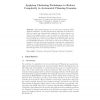IVA
2010
Springer
13 years 10 months ago
2010
Springer
We describe a new organization for virtual human responses to dynamically occurring events. In our approach behavioral responses are enumerated in the representation of the event i...
IVA
2010
Springer
13 years 10 months ago
2010
Springer
Acknowledging the social functions that emotions serve, there has been growing interest in the interpersonal effect of emotion in human decision making. Following the paradigm of e...
IVA
2010
Springer
13 years 10 months ago
2010
Springer
We present a velocity-based model for realistic collision avoidance among virtual characters. Our approach is elaborated from experimental data and is based on the simple hypothesi...
IVA
2010
Springer
13 years 10 months ago
2010
Springer
Abstract. The human ability to express and recognize emotions plays an important role in face-to-face communication, and as technology advances it will be increasingly important fo...
IVA
2010
Springer
13 years 10 months ago
2010
Springer
Many potential applications of virtual agents require an agent to conduct multiple conversations with users. An effective and engaging agent should modify its behavior in realisti...
IVA
2010
Springer
13 years 10 months ago
2010
Springer
Abstract. While interactive virtual humans are becoming widely used in education, training and therapeutic applications, building animations which are both realistic and parameteri...
IVA
2010
Springer
13 years 10 months ago
2010
Springer
We present an episodic memory component for enhancing the dialogue of artificial companions with the capability to refer to, take up and comment on past interactions with the user...
IDEAL
2010
Springer
13 years 10 months ago
2010
Springer
Intrusion detection in computer networks faces the problem of a large number of both false alarms and unrecognized attacks. To improve the precision of detection, various machine l...
IDEAL
2010
Springer
13 years 10 months ago
2010
Springer
Dimension reduction for regression (DRR) deals with the problem of finding for high-dimensional data such low-dimensional representations, which preserve the ability to predict a ...
IDEAL
2010
Springer
13 years 10 months ago
2010
Springer
Automated Planning is a very active area of research within Artificial Intelligence. Broadly this discipline deals with the methods by which an agent can independently determine t...




